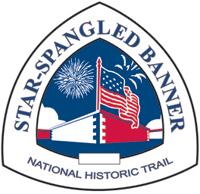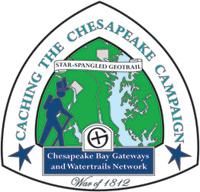During the first challenge along the Star-Spangled Banner GeoTrail, over 400 first edition SSB geocoins were awarded. We would like to thank everyone who participated in the Star-Spangled Banner GeoTour. We are currently out of geocoins but stay tuned for other opportunities along the Star-Spangled Banner GeoTour! A new challenge with a new prize will be ready in 2015.


Come on a journey to remember and commemorate the dramatic chain of events, people and places that led to the birth of our National Anthem.
The story of the Star-Spangled Banner was shaped by the events of the Chesapeake Campaign during the War of 1812. From February 1813 until February 1815, the Chesapeake Bay was the center of a fierce struggle between the British and Americans. Places and landscapes still exist today that provide a touchstone to the past. The trail traces events and related sites that figured prominently in the Chesapeake Campaign of the War of 1812 that have national significance, physical integrity, and the potential for contemporary recreation and interpretation.
The Star-Spangled Banner (SSB) Geotrail launched February 27, 2010 with over 30 caches within Maryland, Virginia and the District of Columbia. A trackable geo coin will be awarded to the first 400 geocachers, while supplies last, for locating at least 20 SSB caches. To be eligible for the coin, geocachers must download a passport from either the SSB Geotrail or Maryland Geocaching Society website. Geocachers must find and log at least 20 SSB finds, record the code word from each cache on their passport and post a picture of themselve at each cache location. After discovering the 20 required caches, geocachers may have their passports validated in person or via mail at the Friends of Chesapeake Gateways office located at 410 Severn Ave, Suite 314, Annapolis, MD 21403. Please refer to the passport for complete validation instructions.
Participating in the SSB geotrail is fun and we hope that many people join in. However, it is not a requirement for logging your find on this cache once you find the container.

This is an easy to find traditional hide located at the beautiful Mt. Calvert. There is no fee to enter this park. The park is open dawn to dusk.
Mount Calvert, home to more than 8,000 years of history, is one of the most significant cultural and archaeological sites in Prince George's County. On its grounds, scholars have found evidence showing that American Indians were present from as long ago as the Archaic Period, roughly 7500-1000 BC. Early on, hunters and gathers visited the area to harvest the Patuxent River’s natural resources and while later, farmers worked the land and lived in permanent villages until arrival of European settlers in the 1600's displaced the native communities.
The English colonial town at Mount Calvert was established by the 1684 Act for the Advancement of trade. When Prince George's County was organized in 1696, it became the county seat and was renamed Charles Town. It remained the center of government until 1721, when Upper Marlboro took that honor. Charles Town gradually disappeared thereafter and Mount Calvert became a ferry landing. Between the 1780s and 1860s, Mount Calvert was a tobacco plantation. The brick plantation house (built in the 1780s) housed the families of the various owners, including John Brown, John Brooks and Samuel Berry. The Mount Calvert plantation depended on labor from enslaved people and by the mid-1800s, fifty-one enslaved African-Americans lived and worked on-site.
As described in the soon to be published book, The War of 1812 in the Chesapeake: A Reference Guide to Historic Sites in Maryland, Virginia, and the District of Columbia, Mount Calvert was the location where Rear Admiral George Cockburn, among the most hated of British wartime leaders, disembarked his seamen to join the marines on their fateful march to the American capital of Washington D.C. in August 1814. This followed the fiery destruction of the Chesapeake Flotilla, ordered by Commander Joshua Barney, at Pig Point (now called Bristol Landing). The Flotilla had been the Americans best attempt to challenge British Naval dominance on the Chesapeake, but finally succumbed to the invaders’ superior forces after a series of valiant battles up and down the Patuxent River. After British forces moved on from the site, Mount Calvert served as U.S. Navy marshaling and trans-shipment area for materials salvaged from the scuttled Flotilla and as base for USS Asp during these operations in September-October, 1814.
Today, an interpretive trail and a museum exhibit tell the story of Mount Calvert's past. Signs along the trail highlight American Indian cultures, colonial Charles Town, a 19th century, African-American history, the War of 1812, and the Chesapeake Beach Railway. Located in the restored plantation house, the exhibit, A Confluence of Three Cultures, depicts the life-ways of American Indians, English Colonists, and African-Americans at Mount Calvert. Artifacts such as stone tools, pottery, glass beads, shells, bones, tobacco pipes, glass bottles and shoe buckles help reveal the stories of past cultures. The park features ongoing archaeological and historical research and provides programs and hands-on activities for the public. Hiking is also permitted. Relic or artifact collecting is strictly prohibited.

Thanks to Chris Garrett of the M-NCPPC Park Rangers for helping with this hide and to the Maryland Geocaching Society for assisting with this project!